Ensuring Sustainable Preservation: Fire Protection of Timber Sacral Buildings in Eastern Slovakia
Abstract
1. Introduction
History of Fires in Our Region
2. Materials and Methods
- Type of building substrate, type of building material, insulation, and lightning rods.
- Fire protection coating, electric fire alarm system, stable fire extinguishing system, and portable fire extinguishers.
- Number of escape routes and emergency lighting.
- Combustible materials inside and outside the building.
- Maintenance of grassland in the vicinity of the building.
- Water source and elevation of the building from the road.
- Volunteer fire brigade of the municipality.
- Access road, approach area and permanent access to the building.
- Marked with a blue marker—Brežany.
- Marked with a red marker, shown in Figure 3b—Kožany, Potoky, Ladomirová, Krajné Čierno, Šemetkovce, Dobroslava, Korejovce, Nižný Komárnik, Hunkovce, Príkra, Miroľa, Bodružal.
- Marked with a yellow sign, shown in Figure 3a—Uličské Krivé, Ruský Potok, Topoľa, Kalná Roztoka, Šmigovec, Hrabová Roztoka, Ruská Bystrá, Inovce.
3. Results
3.1. Timber Sacral Buildings
3.2. Fire Resistant Coating
3.3. Electric Fire Alarm System
3.4. Fire Extinguishers
3.5. Stable Fire Extinguishing Equipment
3.6. Evacuation
3.7. Flammable Material
3.8. Maintenance of Grassland near the Building
3.9. Water Source
3.10. Voluntary Fire Brigades
3.11. Access Communications and Boarding Areas
- tj—time of arrival of the firefighting unit
- L—distance to the place of fire (km)
- vj—average speed of fire trucks = 45 km·h−1
| Building in Village | Year of Construction | Fire Station | Distance (km) | Arrival Time (min:s) |
|---|---|---|---|---|
| Brežany | 1727 | FS Prešov | 15.4 | 20:32 |
| Kožany | 1760 | FS Giraltovce | 17.8 | 23:44 |
| Potoky | 1773 | FS Stropkov | 6.4 | 8:32 |
| Ladomirová | 1742 | FS Svidník | 4.8 | 6:24 |
| Krajné Čierno | 1730 | FS Svidník | 8.8 | 11:44 |
| Šemetkovce | 1752 | FS Svidník | 10.2 | 13:36 |
| Dobroslava | 1715 | FS Svidník | 7.5 | 10 |
| Korejovce | 1764 | FS Svidník | 10.6 | 14:08 |
| Nižný Komárnik | 1938 | FS Svidník | 13 | 17:20 |
| Hunkovce | 1799 | FS Svidník | 8.7 | 11:36 |
| Príkra | 1776 | FS Svidník | 16.2 | 21:36 |
| Miroľa | 1770 | FS Svidník | 16.8 | 22:24 |
| Bodružal | 1658 | FS Svidník | 13.6 | 18:08 |
| Kalná Roztoka | 1750 | FS Snina | 14.4 | 19:12 |
| Topoľa | 1700 | FS Snina | 24.9 | 33:12 |
| Ruský Potok | 1750 | FS Snina | 31.5 | 42 |
| Uličské Krivé | 1718 | FS Snina | 35.9 | 47:52 |
| Ruská Bystrá | 1730 | FS Sobrance | 24.8 | 33:04 |
| Inovce | 1836 | FS Sobrance | 19.6 | 26:08 |
| Hrabová Roztoka | 1750 | FS Sobrance | 28.4 | 37:52 |
| Šmigovec | 1780 | FS Sobrance | 26.1 | 34:48 |
4. Discussion
4.1. Timber Sacral Buildings
4.2. Fire Resistant Coating
4.3. Electric Fire Alarm System
4.4. Fire Extinguishers
4.5. Stable Fire Extinguishing Equipment
4.6. Evacuation
4.7. Flammable Material and Maintenance of Grassland near the Building
4.8. Water Source
4.9. Voluntary Fire Brigades
5. Conclusions
- Building base made of non-combustible materials.
- Possibility to remove combustible material from the surroundings of the objects.
- Presence of fire extinguishers in the premises except one.
- The electric fire alarm system was functional in only 11 buildings.
- There is no stable fire extinguishing system in any of the buildings.
- Fire protection coating was applied to 12 buildings, but many of them were already past their expected lifetime.
- Water sources, where they are located and what the water source is.
- Access and approach areas, and their distance from the objects.
- Accessibility to the facility during the winter months.
Author Contributions
Funding
Institutional Review Board Statement
Informed Consent Statement
Data Availability Statement
Acknowledgments
Conflicts of Interest
References
- Nilsson, T.; Rowell, R. Historical wood–structure and properties. J. Cult. Herit. 2012, 13, S5–S9. [Google Scholar] [CrossRef]
- Dejiny Pamiatkovej Starostlivosti. Pamiatkový Úrad Slovenskej Republiky (History of Monument Care. Monuments Authority of the Slovak Republic). Available online: https://www.pamiatky.sk/ochrana-pamiatok/dejiny-pamiatkovej-starostlivosti/ (accessed on 22 January 2024). (In Slovak).
- Salleh, N.H.; Mohtar, M.A.W. Active Fire Safety Measures in The Heritage Timber Buildings in Malaysia. Plan. Malays. 2020, 18, 2. [Google Scholar] [CrossRef]
- Torero, J.L. Fire Safety of Historical Buildings: Principles and Methodological Approach. Int. J. Archit. Herit. 2019, 13, 926–940. [Google Scholar] [CrossRef]
- Neto, J.T.; Ferreira, T.M. Assessing and mitigating vulnerability and fire risk in historic centres: A cost-benefit analysis. J. Cult. Herit. 2020, 45, 279–290. [Google Scholar] [CrossRef]
- Shabani, A.; Kioumarsi, M.; Plevris, V.; Stamatopoulos, H. Structural Vulnerability Assessment of Heritage Timber Buildings: A Methodological Proposal. Forests 2020, 11, 881. [Google Scholar] [CrossRef]
- Tóth, A. Small Sacred Architecture in Scenic and Cultural Landscapes. Bratislava. Environment 2020, 53, 159–165. [Google Scholar]
- Špilák, D.; Majlingová, A.; Kačíková, D. Progressive Methods for Determining the Fire Resistance of Wooden Beams, 1st ed.; Aleš Čeněk: Prague, Czech Republic, 2022; 162p. [Google Scholar]
- Kozłowski, R. Wooden heritage buildings and preventing them against fire. Bud. Archit. 2015, 14, 079–087. [Google Scholar] [CrossRef]
- Tsapko, J.; Bondarenko, O.; Tsapko, A.; Gorbachova, A.Y.; Mazurchuk, S.; Zherebchuk, D. Justification of The Efficiency of Floating Coating for Fire Protection of Wooden Buildings. Mod. Constr. Archit. 2023, 3, 49–60. [Google Scholar] [CrossRef]
- Liu, T.; Li, A.; Yao, M.; Deng, J.; Huang, Q.; Li, Z.; Li, H.; Yi, X. Fire Behavior Characteristics and Computational Simulation Research on Historic Wooden Structures. Fire 2024, 7, 478. [Google Scholar] [CrossRef]
- Kincelova, K.; Boton, C.; Blanchet, P.; Dagenais, C. Fire Safety in Tall Timber Building: A BIM-Based Automated Code-Checking Approach. Buildings 2020, 10, 121. [Google Scholar] [CrossRef]
- Vovk, S.; Ferents, N.; Lyn, A. Religious Buildings Fire Safety in Ukraine. Fire Saf. 2020, 37, 24–30. [Google Scholar] [CrossRef]
- Ioannidis, A.I.; Mikropoulos, P.N.; Tsovilis, T.E.; Kokkinos, N.D. Evaluating protection against lightning for historical buildings and cultural heritage monuments. Electr. Power Syst. Res. 2024, 230, 2. [Google Scholar] [CrossRef]
- Historic England 2019. Lightning Protection: Design and Installation for Historic Buildings. Swidon. Historic England, April 2019. Available online: https://historicengland.org.uk/images-books/publications/lightning-protection/heag182-lightning-protection/ (accessed on 1 April 2019).
- Fisher, C.E. Lightning Protection for Historic Structures. In 50 Preservation Briefs; Government Printing Office: Washington, DC, USA, 2017; pp. 1–20. Available online: https://www.nps.gov/orgs/1739/upload/preservation-brief-50-lightning-protection.pdf (accessed on 1 October 2019).
- Gomes, C.; Kadir, Z.; Izadi, M.; Gomes, A. Lightning current and voltage distribution of large axially symmetric buddhist stupa in Sri Lanka. In Proceedings of the 32nd International Conference on Lightning Protection (ICLP), Shanghai, China, 11–17 October 2014; pp. 1480–1494. [Google Scholar] [CrossRef]
- Selvaraj, T.; Srinivasan, V.; Raneri, S.; Fernando, M.; Kakria, K.; Jayasingh, S. Response of organic lime mortars to thermal and electrical shocks due to lightning strikes. Sustainability 2020, 12, 7181. [Google Scholar] [CrossRef]
- Venkatesh, S.; Fernando, M.; Kumara, S.; Selvaraj, T.; Cooray, V. Modeling and assessment of lightning hazards to humans in heritage monuments in India and Sri Lanka. IEEE Access 2020, 8, 228032–228048. [Google Scholar] [CrossRef]
- Srisailam, S.; Venkatesh, S. Lightning strokes and its effects on historical monuments, heritage properties and important landmarks a detailed perspective of traditional and scientific methods of lightning protection systems. Int. J. Eng. Technol. 2018, 7, 784–794. [Google Scholar] [CrossRef]
- Venkatesh, S.; Selvaraj, T.; Chandrasekaran, S.; Srisailam, S.; Kakria, K.S.; Fernando, R.; Kumara, S. Three-Dimensional Implementation of Modified Rolling Sphere Method for Lightning Protection of Giant Medieval Chola Monument in South India. In Proceedings of the 14th Conference on Industrial and Information Systems (ICIIS), Kandy, Sri Lanka, 18–20 December 2019; pp. 535–540. [Google Scholar] [CrossRef]
- Srisailam, S.; Indragandhi, V. A Comprehensive Framework for Direct Lightning-Structure-Human Interaction Modelling in Heritage Monuments and Safety Assessment. Energies 2022, 15, 7053. [Google Scholar] [CrossRef]
- Sharma Gyawali, S.; Gomes, C.; Sharma, S. Archaeological sites in Nepal and India: Concerns of lightning risks. In Proceedings of the 36th International Conference on Lightning Protection (ICLP), Cape Town, South Africa, 2–7 October 2022; pp. 734–740. [Google Scholar] [CrossRef]
- Chang, W.Y.; Tang, C.H.; Lin, C.Y. Estimation of Magnitude and Heat Release Rate of Fires Occurring in Historic Buildings-Taking Churches as an Example. Sustainability 2021, 13, 9193. [Google Scholar] [CrossRef]
- Dangers to the Sacred Wooden Architecture in Poland. Heritage at Risk. ICOMOS World Report 2002–2003 on Monuments and Sites in Danger. Available online: https://www.icomos.org/public/risk/2002/poland2002.htm (accessed on 22 January 2024).
- Quapp, U.; Holschemacher, K. Heritage Protection Regulations in Germany and their Relations to Fire Safety Demands. IOP Conf. Ser.: Mater. Sci. Eng. 2020, 753, 042036. [Google Scholar] [CrossRef]
- Kristoffersen, M.; Log, T. Experience gained from 15 years of fire protection plans for Nordic wooden towns in Norway. Safety Science 2022, 146, 105535. [Google Scholar] [CrossRef]
- Jensen, G. A White Paper on Water Mist for Protection of Heritage; Interconsult ASA: Trondheim, Norway, 2004; 44p, Available online: https://www.fireriskheritage.net/wp-content/uploads/Water-Mist-in-Heritage-Report-12-July-2004.pdf (accessed on 22 January 2024).
- Arvidson, M. An Overview of Fire Protection of Swedish Wooden Churches; SP Fire Technology SP Report; SP Swedish National Testing and Research Institute: Boras, Sweden, 2006; 102p, Available online: https://www.diva-portal.org/smash/get/diva2:962374/FULLTEXT01.pdf (accessed on 22 January 2024).
- Kincaid, S. Fire prevention in historic buildings–approaches for safe practice. Hist. Environ. Policy Pract. 2022, 13, 361–380. [Google Scholar] [CrossRef]
- Historic Scotland. Fire Protection and the Built Environment: Conference Proceedings; Historic Scotland: Edinburgh, Scotland, 1999; Available online: https://www.historicenvironment.scot/archives-and-research/publications/publication/?publicationid=b6cdb9b7-3351-4773-80fb-a5aa00e55dff (accessed on 12 February 1999).
- Sardaro, R.; La Sala, P.; De Pascale, G.; Faccilongo, N. The conservation of cultural heritage in rural areas: Stakeholder preferences regarding historical rural buildings in Apulia, southern Italy. Land Use Policy 2021, 109, 105662. [Google Scholar] [CrossRef]
- Cleef, L.; Yang, M.; Bouchaut, B.; Reniers, G. Fire risk assessment tools for the built environment-An explorative study through a developers’ survey. Fire Saf. J. 2024, 146, 104169. [Google Scholar] [CrossRef]
- Malatinský, A.; Hromada, M. Prognosis for the Development of Vulnerability of Objects within the Fire Protection. Transactions of the VŠB Technical University of Ostrava. Saf. Eng. Ser. 2021, 16, 18–28. [Google Scholar] [CrossRef]
- Law, A.; Hadden, R. We need to talk about timber: Fire safety design in tall buildings. Struct. Eng. 2020, 98, 6. Available online: https://www.istructe.org/journal/volumes/volume-98-(2020)/issue-3/we-need-to-talk-about-timber-fire-safety-design-in/ (accessed on 3 March 2020). [CrossRef]
- Wooden Churches of UNESCO World Heritage. Ministry of Tourism and Sports of the Slovak Republic. Available online: https://slovakia.travel/en/wooden-churches-of-unesco-world-heritage (accessed on 24 January 2025).
- Kurilcová, A. Grekokatolícka cirkev na Slovensku po roku 1989 a jej rozvoj v oblasti architektúry (The Greek Catholic Church in Slovakia after 1989 and its development in the field of architecture). In Súčasné Trendy a Výzvy v Katolíckej Teológii a Religionistike Zborník z Odbornej Konferencie Mladých Vedeckých Pracovníkov; University of Prešov: Prešov, Slovakia, 2015; 187p. (In Slovak) [Google Scholar]
- Riaz, M.R.; Mustafvi, J.B.; Ishtiaq, M.S. Fire Risk Assessment for Heritage Structures of Lahore: Current Situation and Contributing Factors. J. Art Archit. Built Environ. 2023, 6, 137–163. [Google Scholar] [CrossRef]
- Papáč, R. Požiar Košíc v Roku 1556 (Fire of Košice at 1556). Košiceonline.sk 2022. Available online: https://www.kosiceonline.sk/poziar-kosic-v-roku-1556 (accessed on 22 January 2024). (In Slovak).
- História Obce Rafajovce (About the Village of Rafajovce). Available online: https://rafajovce.sk/historia/ (accessed on 22 January 2024). (In Slovak).
- O Obci Jasenová (About the Village of Jasenová). 2022. Available online: https://www.jasenova.sk/o-obci.html (accessed on 22 January 2024). (In Slovak).
- Kostka, O. Z histórie Farnosť Spišské Hanušovce (From the History of the Parish of Spišské Hanušovce). 1966. Available online: https://www.farnostsh.sk/historia/z-historie/ (accessed on 22 January 2024). (In Slovak).
- Collective of Authors. Vlastivedný Slovník Obcí na Slovensku, 1. Časť; SAV Bratislava: Bratislava, Slovakia, 1978; p. 526. ISBN 71-019-77. (In Slovak) [Google Scholar]
- História Dobrovoľného Hasičského Zboru Obce Liptovský Peter (History of the Voluntary Fire Department of the Municipality of Liptovský Peter). 2020. Available online: https://www.liptovskypeter.sk/8704/historia (accessed on 22 January 2024). (In Slovak).
- Syrochman, M.; Džoganík, J. Stratené Drevené Cerkvi Severovýchodného Slovenska–Znovunájdené (Lost Wooden Churches of Northeastern Slovakia–Rediscovered), 1st ed.; Ruthenian-Ukrainian Initiative: Svidník, Slovakia, 2019; 80p, ISBN 978-80-89755-74-5. Available online: https://www.pamiatky.sk/aktuality/detail/stratene-drevene-cerkvi-severovychodneho-slovenska-znovunajdene (accessed on 22 April 2020). (In Slovak)
- V Hornej Maríkovej Zhorel Drevený Kostolík (A Wooden Church Burned Down in Horná Maríková). Fire and Rescue Service. Ministry of the Interior of the Slovak Republic. 2016. Available online: https://www.minv.sk/?tlacove-spravy-3&sprava=v-hornej-marikovej-zhorel-dreveny-kostolik (accessed on 22 January 2024). (In Slovak).
- V Třinci Zhorel Drevený Kostol zo 16. Storočia (A 16th-Century Wooden Church Burned Down in Třinec). Slovak Press Agency. 2017. Available online: https://spravy.pravda.sk/svet/clanok/437131-v-trinci-zhorel-dreveny-kostol-zo-16-storocia/ (accessed on 22 January 2024). (In Slovak).
- Požiar v Česku Takmer Úplne Zničil Vzácny Drevený Kostol (A Fire in the Czech Republic Almost Completely Destroyed a Rare Wooden Church). Press Agency of the Slovak Republic. 2020. Available online: https://www.teraz.sk/zahranicie/poziar-v-cesku-takmer-uplne-znicil-z/503670-clanok.html (accessed on 22 January 2024). (In Slovak).
- Higgins, W.Y.; Boorman, D.J. An Analysis of the Effectiveness of Checklists When Combined with Other Processes, Methods and Tools to Reduce Risk in High Hazard Activities. Boeing Tech. J. 2016. Available online: https://www.flighttestsafety.org/images/BTJ_Checklist_full1.pdf (accessed on 1 January 2016).
- Google Maps. Available online: https://www.google.com/maps (accessed on 20 February 2025).
- Jirásek, P.; Mrázek, M.; Polatová, E.; Svoboda, P. Fire Protection of Heritage Buildings, 1st ed.; National Heritage Institute: Prague, Czech Republic, 2014; ISBN 978-80-7480-021-4. [Google Scholar]
- Kučera, P.; Kaiser, R.; Pavlík, T.; Pokorný, J. Methodological Procedure for a Different Way of Meeting the Technical Conditions of Fire Protection, 1st ed.; Publisher Association of Fire and Safety Engineering: Ostrava, Czech Republic, 2008. [Google Scholar]
- Venegas, D.; Erazo, O.; Farías, Ó.; Ayabaca, C.; Medina, A. Fires in World Heritage Buildings. In Artificial Intelligence, Computer and Software Engineering Advances; Botto-Tobar, M., Cruz, H., Díaz Cadena, A., Eds.; CIT 2020, Advances in Intelligent Systems and Computing; Springer: Cham, Switzerland, 2012; Volume 1326. [Google Scholar] [CrossRef]
- Black Metal Church Burnings: A Historical View. 2018. Available online: https://stainedglassattitudes.wordpress.com/2018/01/13/black-metal-church-burnings-a-historical-view/ (accessed on 13 January 2018).
- Garcia-Castillo, E.; Payá-Zaforteza, I.; Hospitaler, A. Fire in Heritage and Historic Buildings, a Major Challenge for the 21st century. Dev. Built Environ. 2023, 13, 100102. [Google Scholar] [CrossRef]
- Register Pamiatkových Objektov, Pamiatkový Úrad Slovenskej Republiky (Register of Monuments, Monuments Office of the Slovak Republic). Bratislava. Available online: https://www.pamiatky.sk/evidencie-a-registre/register-po (accessed on 15 January 2025). (In Slovak).
- Vyhláška Ministerstva Vnútra Slovenskej Republiky č. 94/2004 Z.z. Ktorou sa Ustanovujú Technické Požiadavky na Protipožiarnu Bezpečnosť pri Výstavbe a Pri Užívaní Stavieb (Decree of the Ministry of the Interior of the Slovak Republic No. 94/2004 Coll. Establishing Technical Requirements for Fire Safety During the Construction and Use of Buildings). Bratislava. Available online: https://www.slov-lex.sk/ezbierky/pravne-predpisy/SK/ZZ/2004/94/ (accessed on 1 January 2019). (In Slovak).
- Pokyn Prezidenta Hasičského a Záchranného Zboru o Obsahu a č. 39 z Roku 2003 o Postupe pri Spracúvaní Dokumentácie o Zdolávaní Požiarov Zbierka Pokynov Prezídia Hasičského a Záchranného Zboru; (Instruction of the President of the Fire and Rescue Corps on the Content and No. 39 of 2003 on the Procedure for Processing Documentation on Fighting Fires Collection of Instructions of the Presidium of the Fire and Rescue Corps. Ministry of the Interior of the Slovak Republic. Bratislava); Ministerstvo Vnútra Slovenskej Republiky: Bratislava, Slovak Republic, 2003. (In Slovak)
- MariusLtu. Fantoft Stave Church. iStock. Available online: https://www.istockphoto.com/cs/fotografie/fantoft-stave-kostel-gm622806880-109080589?clarity=false (accessed on 28 February 2025).
- Hu, H. Impact of climatic-meteorological conditions on Polish wooden cultural heritage: An example of world heritage sites featuring wooden churches near Krakow. Humanit. Soc. Sci. Commun. 2024, 11, 1318. [Google Scholar] [CrossRef]
- The Foundation to Preserve Ukraine’s Sacral Arts, ICOMOS and World Monuments Fund Deliver Fire Extinguishers to Protect Ukraine’s Wooden Churches. 2022. Available online: https://www.icomos.org/images/DOCUMENTS/Secretariat/2022/Ukraine/FTPUSA-ICOMOS-WMF_release_EN_final20220711.pdf (accessed on 22 January 2024).
- Polatová, E. Požární Ochrana Norských a Polských Dřevěných Památkově Chráněných Staveb (Fire Protection of Norwegian and Polish Wooden Heritage Buildings). tzbinfo 2018. Available online: https://www.tzb-info.cz/pozarni-bezpecnost-staveb/17109-pozarni-ochrana-norskych-a-polskych-drevenych-pamatkove-chranenych-staveb (accessed on 22 January 2024). (In Czech).
- Arvidson, M. Experience with Fire Suppression Installations for Wood Churches in Sweden. J. Fire Prot. Eng. 2008, 18, 141–159. [Google Scholar] [CrossRef]
- RPBMMedia. The Stave Church of Borgund in Laerdal. iStock. Available online: https://www.istockphoto.com/cs/fotografie/kostel-stave-v-borgundu-v-laerdalu-norsko-gm653111756-118721333?clarity=false (accessed on 28 February 2025).
- Kubas, J.; Polorecká, M.; Holla, K.; Soltes, V.; Kelisek, A. Use of Toxic Substance Release Modelling Prevention Plenning in Border Areas. Atmosphere 2022, 13, 836. [Google Scholar] [CrossRef]
- Bačík, V. Obce Slovenskej Republiky (Municipalities of the Slovak Republic). Available online: http://www.sodbtn.sk/obce/statistika_obce.php (accessed on 22 January 2024). (In Slovak).
- Dongmei, H.; Liming, L.; HePing, Z. Recent Progresses in Research of Fire Protection on Historic Buildings. J. Appl. Fire Sci. 2009, 19, 63–81. [Google Scholar]
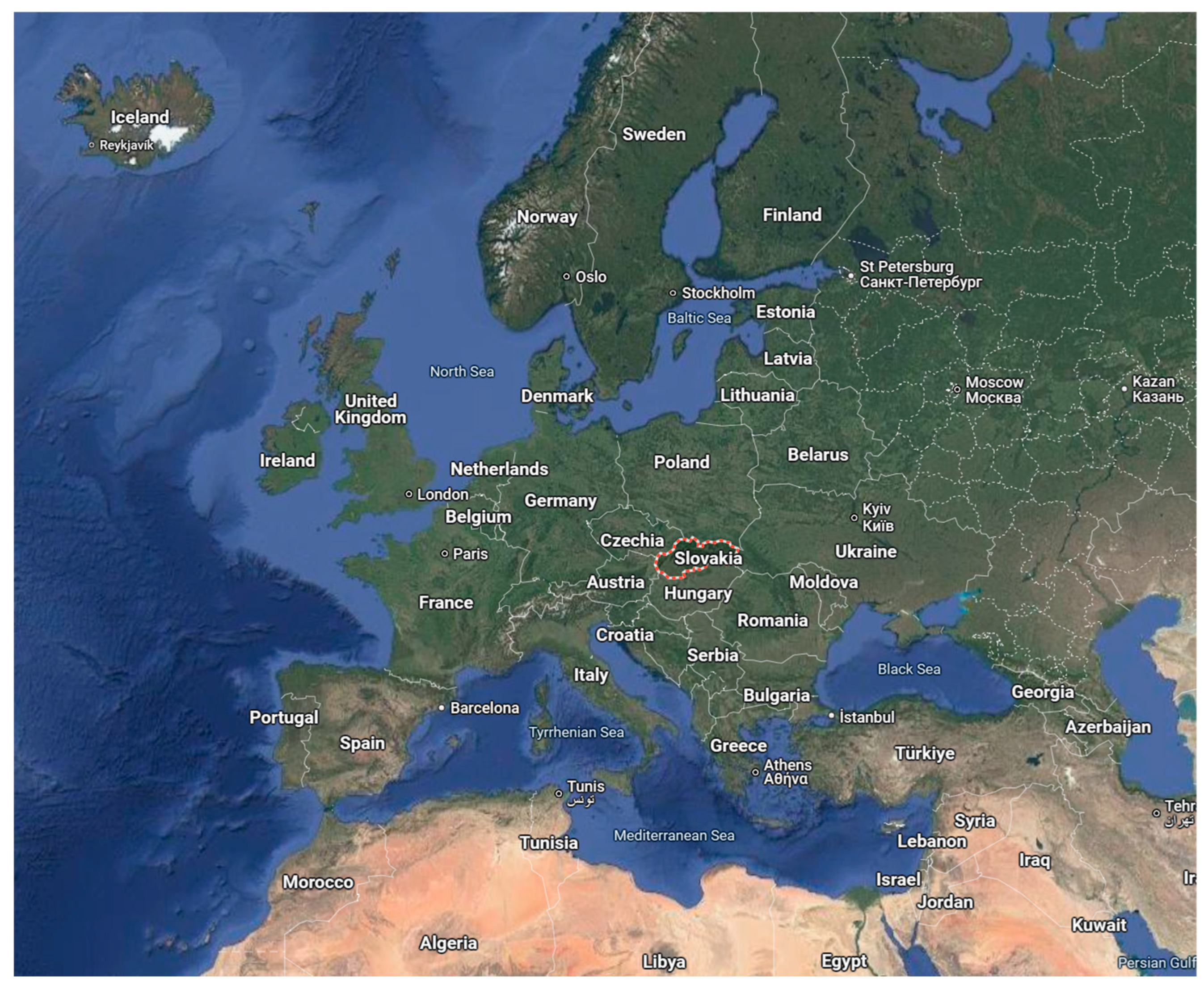
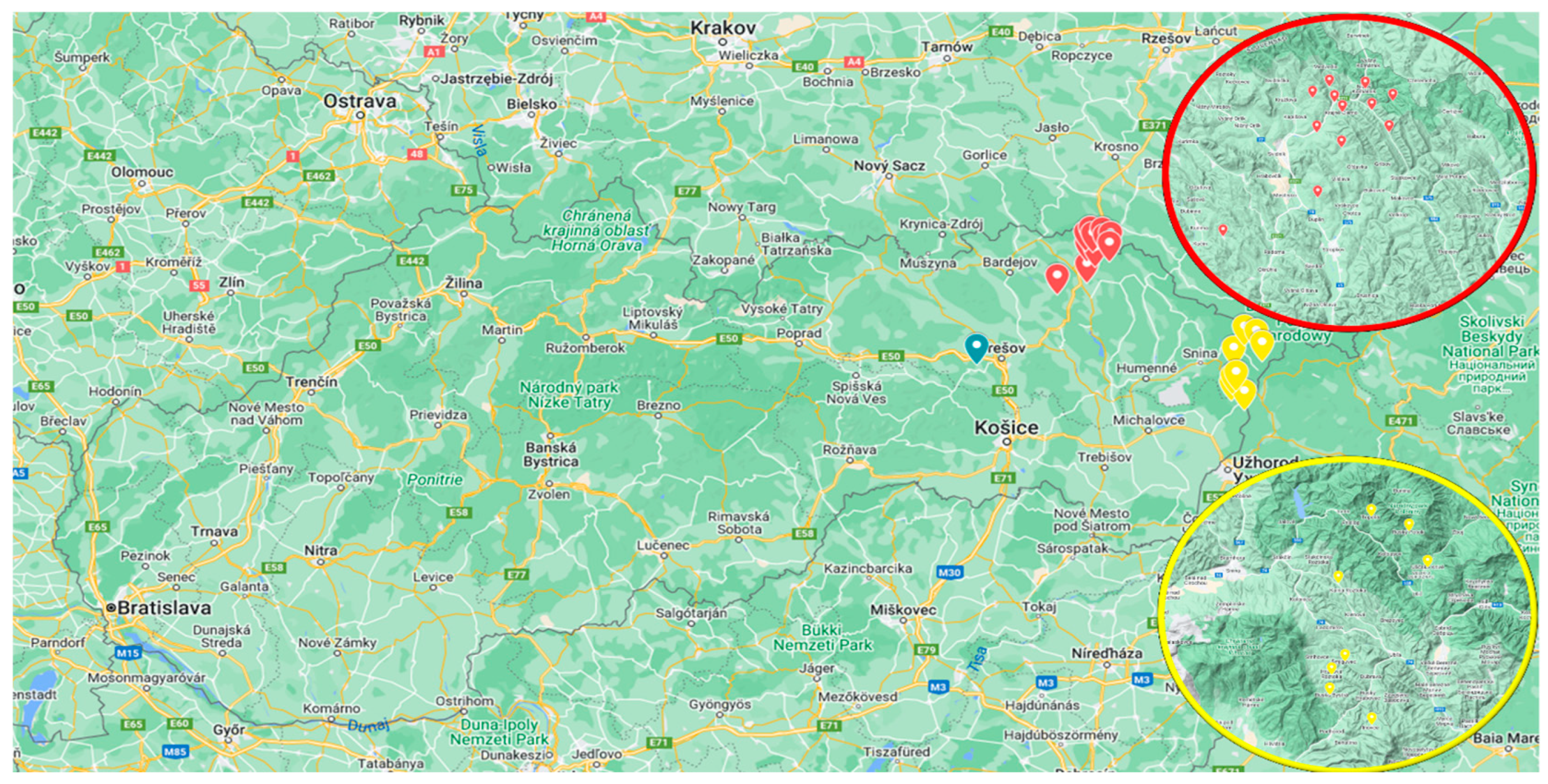


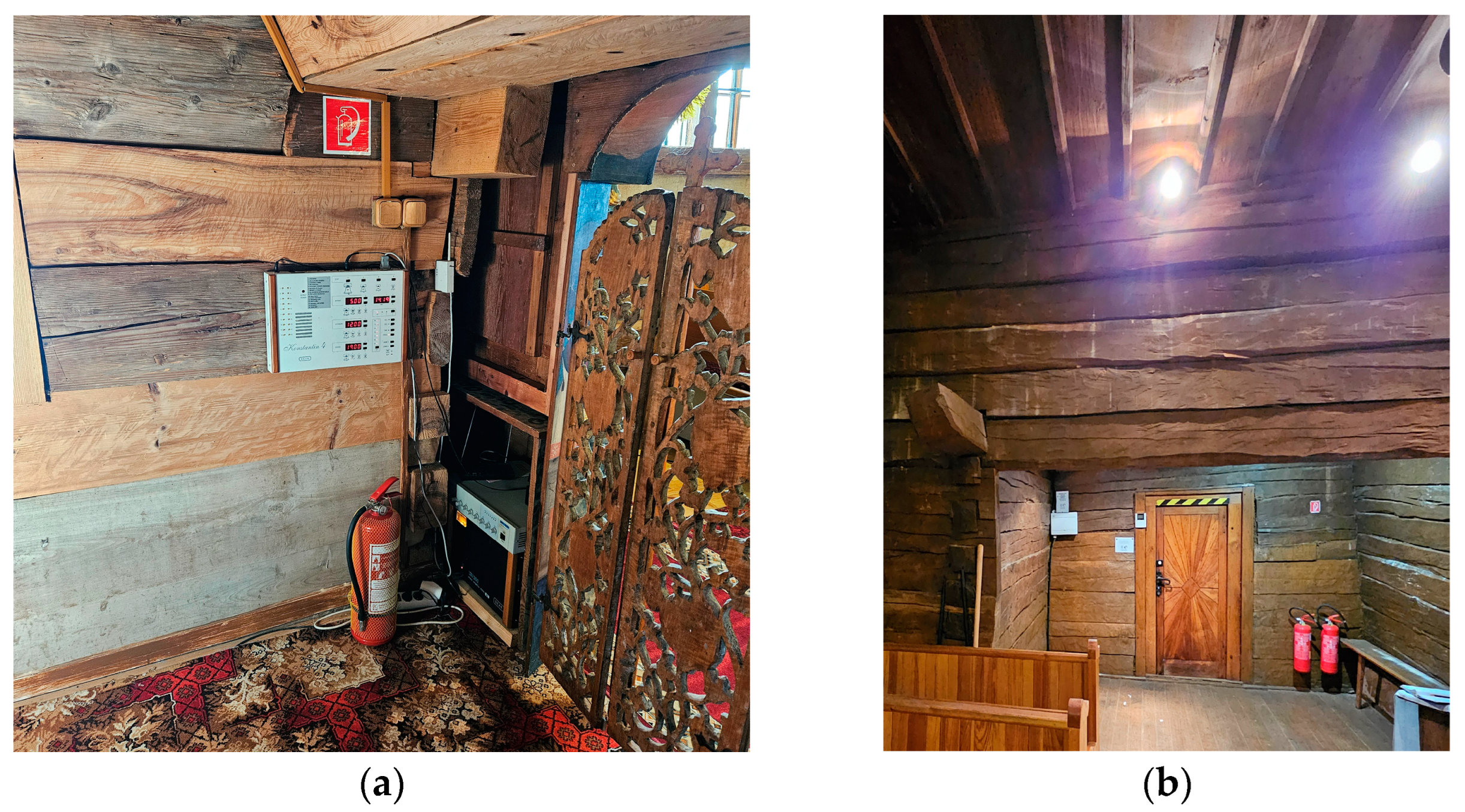
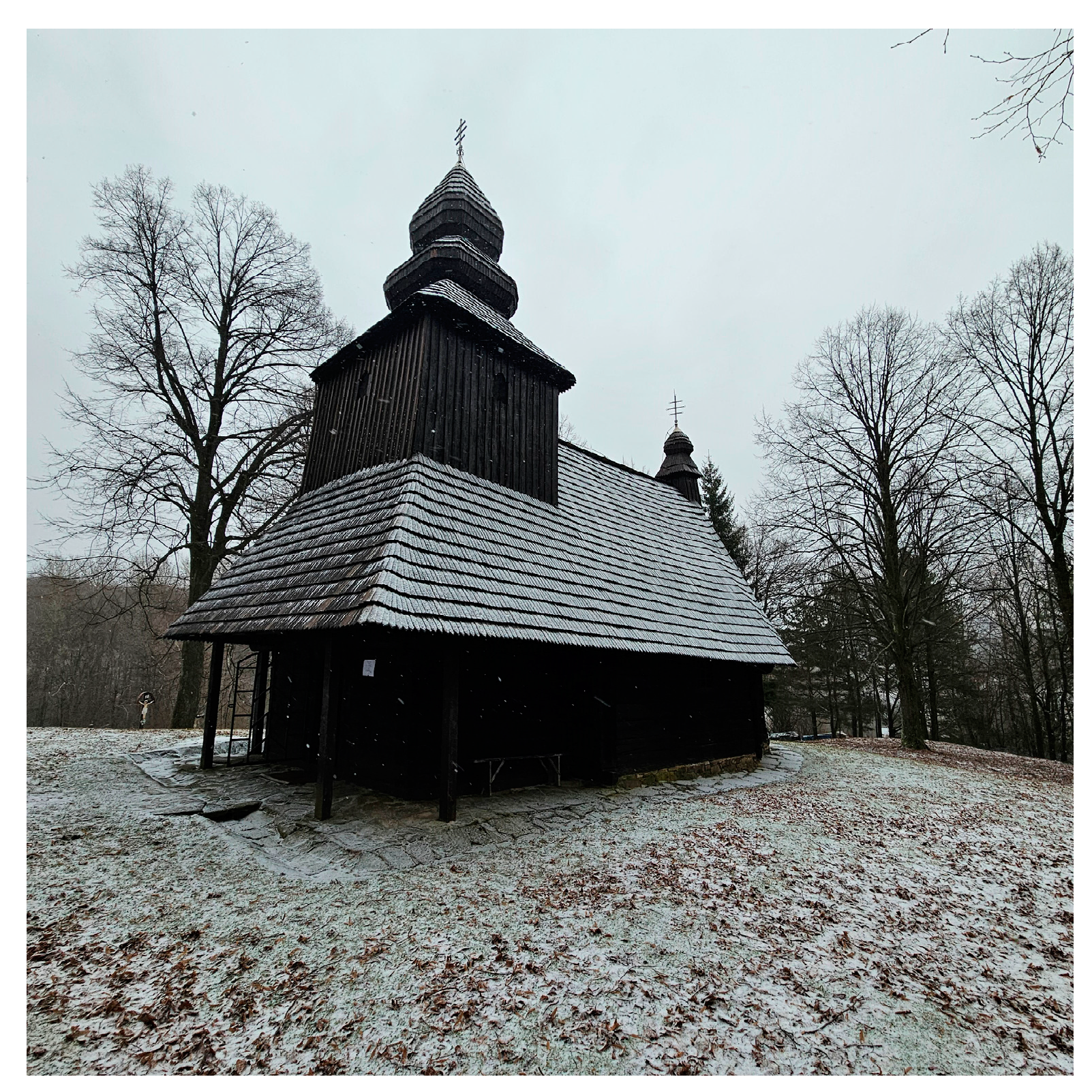

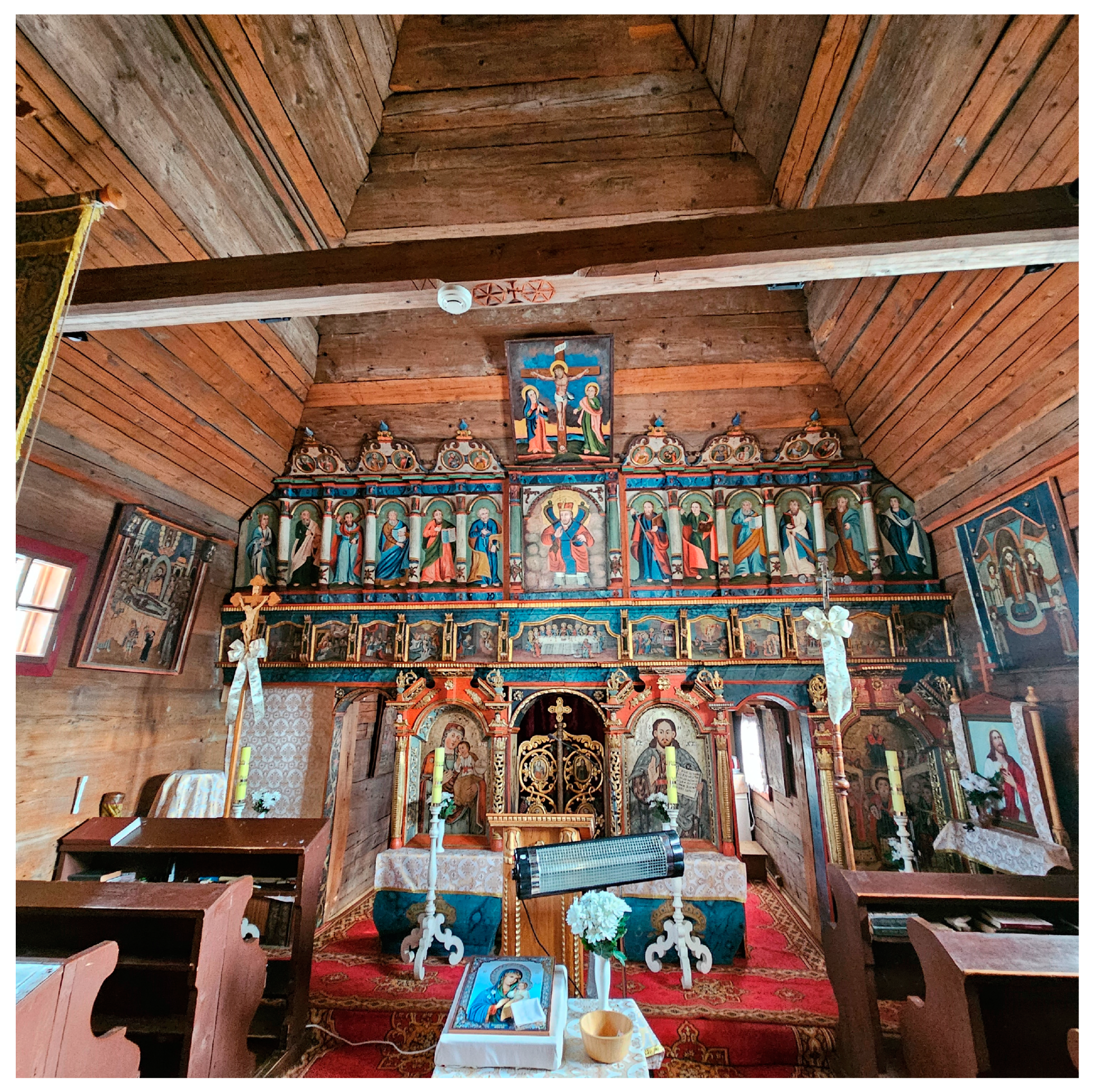



| Brežany | Kožany | Potoky | Ladomirová | Krajné Čierno | Šemetkovce | Dobroslava | Korejovce | Nižný Komárnik | Hunkovce | Príkra | Miroľa | Bodružal | Kalná Roztoka | Topoľa | Ruský Potok | Uličské Krivé | Ruská Bystrá | Inovce | Hrabová Roztoka | Šmigovec | |
|---|---|---|---|---|---|---|---|---|---|---|---|---|---|---|---|---|---|---|---|---|---|
| Fire resistant coating | x | x | ✓ | ✓ | ✓ | ✓ | x | ✓ | x | x | ✓ | x | x | ✓ | ✓ | x | ✓ | ✓ | ✓ | x | ✓ |
| Fireproof lining | x | x | x | x | x | x | x | x | x | x | x | x | x | x | x | x | x | x | x | x | x |
| Lime | x | x | x | x | x | x | x | x | x | x | x | x | x | ✓ | x | x | x | x | x | x | ✓ |
| Brežany | Kožany | Potoky | Ladomirová | Krajné Čierno | Šemetkovce | Dobroslava | Korejovce | Nižný Komárnik | Hunkovce | Príkra | Miroľa | Bodružal | Kalná Roztoka | Topoľa | Ruský Potok | Uličské Krivé | Ruská Bystrá | Inovce | Hrabová Roztoka | Šmigovec | |
|---|---|---|---|---|---|---|---|---|---|---|---|---|---|---|---|---|---|---|---|---|---|
| Present | x | x | ✓ | ✓ | ✓ | ✓ | ✓ | ✓ | ✓ | x | ✓ | ✓ | ✓ | ✓ | ✓ | x | S | N | N | ✓ | N |
| Flame detector | x | x | x | ✓ | x | x | x | ✓ | ✓ | x | ✓ | x | ✓ | x | x | x | x | x | x | x | x |
| Optical-smoke detector | x | x | ✓ | ✓ | ✓ | ✓ | ✓ | ✓ | ✓ | x | ✓ | ✓ | ✓ | ✓ | ✓ | x | ✓ | ✓ | ✓ | ✓ | ✓ |
| Push-button | x | x | x | x | x | x | x | x | x | x | x | x | x | x | x | x | x | x | x | x | x |
| Type of Extinguishing Agent | Brežany | Kožany | Potoky | Ladomirová | Krajné Čierno | Šemetkovce | Dobroslava | Korejovce | Nižný Komárnik | Hunkovce | Príkra | Miroľa | Bodružal | Kalná Roztoka | Topoľa | Ruský Potok | Uličské Krivé | Ruská Bystrá | Inovce | Hrabová Roztoka | Šmigovec |
|---|---|---|---|---|---|---|---|---|---|---|---|---|---|---|---|---|---|---|---|---|---|
| Powder | ✓ | ✓ | ✓ | ✓ | ✓ | ✓ | ✓ | ✓ | ✓ | ✓ | ✓ | ✓ | ✓ | ✓ | ✓ | ✓ | ✓ | ✓ | ✓ | ✓ | x |
| Quantity | 1 | 1 | 3 | 3 | 3 | 3 | 2 | 1 | 2 | 1 | 2 | 2 | 2 | 1 | 1 | 2 | 1 | 1 | 2 | 1 | x |
| Water | ✓ | ✓ | x | x | x | x | x | x | x | x | x | x | x | ✓ | ✓ | x | x | x | x | x | x |
| Quantity | 1 | 1 | x | x | x | x | x | x | x | x | x | x | x | 1 | 1 | x | x | x | x | x | x |
| Type of Material | Brežany | Kožany | Potoky | Ladomirová | Krajné Čierno | Šemetkovce | Dobroslava | Korejovce | Nižný Komárnik | Hunkovce | Príkra | Miroľa | Bodružal | Kalná Roztoka | Topoľa | Ruský Potok | Uličské Krivé | Ruská Bystrá | Inovce | Hrabová Roztoka | Šmigovec |
|---|---|---|---|---|---|---|---|---|---|---|---|---|---|---|---|---|---|---|---|---|---|
| Bench | ✓ | ✓ | ✓ | ✓ | ✓ | ✓ | ✓ | ✓ | ✓ | x | ✓ | ✓ | ✓ | ✓ | ✓ | ✓ | ✓ | ✓ | ✓ | x | ✓ |
| Carpet | ✓ | ✓ | ✓ | ✓ | ✓ | ✓ | ✓ | ✓ | ✓ | x | ✓ | ✓ | ✓ | ✓ | ✓ | x | ✓ | ✓ | x | x | x |
| Tablecloth | ✓ | ✓ | ✓ | ✓ | ✓ | ✓ | ✓ | ✓ | ✓ | x | ✓ | ✓ | ✓ | ✓ | ✓ | ✓ | ✓ | ✓ | ✓ | x | ✓ |
| Candle | ✓ | ✓ | ✓ | ✓ | ✓ | ✓ | ✓ | ✓ | ✓ | x | ✓ | ✓ | ✓ | ✓ | ✓ | ✓ | ✓ | ✓ | ✓ | x | ✓ |
| Other | x | x | x | x | x | x | x | x | x | ✓ | x | x | x | x | x | x | x | ✓ | x | x | x |
| Type of Material | Brežany | Kožany | Potoky | Ladomirová | Krajné Čierno | Šemetkovce | Dobroslava | Korejovce | Nižný Komárnik | Hunkovce | Príkra | Miroľa | Bodružal | Kalná Roztoka | Topoľa | Ruský Potok | Uličské Krivé | Ruská Bystrá | Inovce | Hrabová Roztoka | Šmigovec |
|---|---|---|---|---|---|---|---|---|---|---|---|---|---|---|---|---|---|---|---|---|---|
| Is near by | x | ✓ | x | ✓ | ✓ | ✓ | ✓ | ✓ | ✓ | ✓ | ✓ | ✓ | ✓ | ✓ | ✓ | ✓ | ✓ | ✓ | ✓ | ✓ | ✓ |
| Wooden objects | x | ✓ | x | ✓ | ✓ | ✓ | ✓ | ✓ | ✓ | ✓ | ✓ | ✓ | ✓ | ✓ | ✓ | ✓ | ✓ | ✓ | ✓ | ✓ | ✓ |
| Garland | x | ✓ | x | ✓ | ✓ | x | ✓ | x | ✓ | ✓ | ✓ | x | x | x | x | x | x | x | x | x | x |
| Plastic | x | x | x | ✓ | x | x | x | x | x | x | x | x | x | x | x | x | x | x | x | x | x |
| Others | x | x | x | x | x | x | x | x | x | ✓ | x | x | x | x | x | x | x | x | x | x | x |
| Type of Water Source | Brežany | Kožany | Potoky | Ladomirová | Krajné Čierno | Šemetkovce | Dobroslava | Korejovce | Nižný Komárnik | Hunkovce | Príkra | Miroľa | Bodružal | Kalná Roztoka | Topoľa | Ruský Potok | Uličské Krivé | Ruská Bystrá | Inovce | Hrabová Roztoka | Šmigovec |
|---|---|---|---|---|---|---|---|---|---|---|---|---|---|---|---|---|---|---|---|---|---|
| Hydrant | x | ✓ | ✓ | ✓ | x | x | x | ✓ | ✓ | ✓ | x | ✓ | ✓ | x | x | x | x | x | x | x | x |
| Distance (in metres) | x | 20 | 400 | 70 | x | x | x | 10 | 40 | 50 | x | 20 | 10 | x | x | x | x | x | x | x | x |
| Creek | x | x | x | x | ✓ | x | x | ✓ | x | x | x | x | x | ✓ | ✓ | ✓ | ✓ | ✓ | ✓ | ✓ | ✓ |
| Distance (in metres) | x | x | x | x | 100 | x | x | 30 | x | x | x | x | x | 60 | 80 | 10 | 100 | 500 | 500 | 200 | 50 |
Disclaimer/Publisher’s Note: The statements, opinions and data contained in all publications are solely those of the individual author(s) and contributor(s) and not of MDPI and/or the editor(s). MDPI and/or the editor(s) disclaim responsibility for any injury to people or property resulting from any ideas, methods, instructions or products referred to in the content. |
© 2025 by the authors. Licensee MDPI, Basel, Switzerland. This article is an open access article distributed under the terms and conditions of the Creative Commons Attribution (CC BY) license (https://creativecommons.org/licenses/by/4.0/).
Share and Cite
Huliak, M.; Marková, I. Ensuring Sustainable Preservation: Fire Protection of Timber Sacral Buildings in Eastern Slovakia. Sustainability 2025, 17, 2429. https://doi.org/10.3390/su17062429
Huliak M, Marková I. Ensuring Sustainable Preservation: Fire Protection of Timber Sacral Buildings in Eastern Slovakia. Sustainability. 2025; 17(6):2429. https://doi.org/10.3390/su17062429
Chicago/Turabian StyleHuliak, Michal, and Iveta Marková. 2025. "Ensuring Sustainable Preservation: Fire Protection of Timber Sacral Buildings in Eastern Slovakia" Sustainability 17, no. 6: 2429. https://doi.org/10.3390/su17062429
APA StyleHuliak, M., & Marková, I. (2025). Ensuring Sustainable Preservation: Fire Protection of Timber Sacral Buildings in Eastern Slovakia. Sustainability, 17(6), 2429. https://doi.org/10.3390/su17062429







